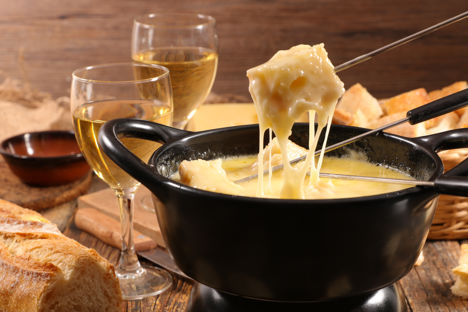
Comté: the ultimate cheese for cooking
Comté’s complex, robust flavour and wonderful melting properties make it a favourite among chefs. We take a look at exactly why this is such a beloved cooking cheese and explore all the things you can do with it.
Comté: the ultimate cheese for cooking
Comté’s complex, robust flavour and wonderful melting properties make it a favourite among chefs. We take a look at exactly why this is such a beloved cooking cheese and explore all the things you can do with it.
Few countries in the world have a tradition of cheese-making to match the French – farming communities all over the country have been making cheese for thousands of years. What started as a simple matter of survival – preserving milk as food for the winter – has become one of France’s gastronomic calling cards. In Franche-Comté on the Franco-Swiss border, farmers watch over herds of Montbéliarde and French Simmental cattle, which graze lazily in the hills. As you might have guessed from the name, this is Comté country – home to one of France’s most famous cheeses.
Comté is highly prized for many reasons. It has an incredible depth of flavour that comes from the quality of the raw milk used to make it, as well as the expertise of the local cheesemakers. When the cheese has been pressed, it goes under the watchful gaze of the affineur, who is responsible for the ageing process. Comté changes a huge amount over the course of its ageing period. In its youth, Comté has fresher, creamier flavours of butter and yoghurt with hints of sweetness and fruit. As it matures, calcium crystals form under the surface. The sweetness deepens and intensifies, building into nuttier, more intense umami flavours. Fresh butter becomes brown butter, and the softer, more malleable texture of young Comté hardens, becoming grainy and crumbly. There’s a misconception that older is better when it comes to Comté – the cheese certainly develops a lot of flavour when it reaches eighteen months old, but young cheeses are no less delicious, and are just as prized by the locals for different dishes.
The classic way to eat Comté, of course, is on a cheeseboard. This is an expertly-crafted cheese – it takes great skill to make cheese from raw milk, and sometimes it’s best to enjoy these things in their own right alongside some fresh fruit and a few chutneys. That said, it also makes an outstanding cooking cheese; in fact, you only have to look to the food of Franche-Comté itself to see that. Famous local dishes like fondue Jurasienne make the most of Comté’s fantastic flavour, but also its excellent melting properties. Fondue was once a sensible way of making a meal out of cheese and stale bread, but now it’s a luxurious dinner, where julienned vegetables, bread and other morsels are dipped in a warm pot of melted cheese. Poulet à la Comtoise is another traditional local dish, where Bresse chicken is cooked in a sauce made with white wine from Jura, crème fraîche and Comté.
Keeping true to French tradition, a soufflé, quiche, omelette or some delightfully puffed gougères are a truly lovely match for Comté – where the cheese can gently melt its way into the essence of the dish. Earthy buckwheat galettes are also greatly improved with a sprinkle of this mountain cheese, as is a Croque monsieur or a Croque madame; toasted sourdough, salty-cured ham, Comté and a fried egg is a weekend breakfast we can all get along with.
Traditional winter warmers suit Comté well, where that intense, comforting flavour really comes to the fore. You can’t go wrong with a layered potato gratin – or another root vegetable if you prefer – topped with plenty of bubbling cheese. There are plenty of other ways to combine Comté and potato – though aligot originates in central France, you could easily make it with Comté instead of the original Tomme. Our Comté pomme duchesse recipe combines Comté with mashed potato, egg yolk and butter before piping and baking in the oven to make beautiful cheesy bites that you could serve alongside a main or as little canapés. Adam Byatt – head chef and founder of Trinity restaurant in London – is a huge fan of Comté and uses it in many dishes, including this decadent oxtail macaroni cheese.
Moving gently away from tradition, however, there are many other possibilities for this cheese’s versatile flavours. A juicy beef burger is the first thing that springs to mind, topped with Comté on buttered brioche, but dig a little deeper and you’ll find Comté makes a great partner to chicken and poultry too. This dish by Martin Wishart serves poached chicken alongside a vin jaune sauce and tasty Comté gnocchi, made by grating the cheese in with the potato before shaping and cooking, and for something simpler, our Comté chicken recipe is simple and showcases the cheese’s incredible flavours beautifully. A great many more things would be enhanced by melting Comté into a white sauce – not just classics like cauliflower cheese but croquettes, which could be filled with silky Comté sauce before being frozen, breadcrumbed and deep-fried.
Comté’s fantastic melting properties also make it a great candidate for baked goods. Grated Comté can be incorporated into all sorts of things – scones, pancakes, bread rolls and more – giving your baked goods a rich, cheesy flavour. Sprinkle a little more Comté over the top for a crispy, caramelised cheesy crust that will definitely win you friends.
The possibilities are almost endless. Comté can be creamy, savoury, fruity, salty, umami, nutty, smoky and sweet – to name but a few of the possible flavours. What style of Comté you choose and what you choose to do with it – these things are up to you.

